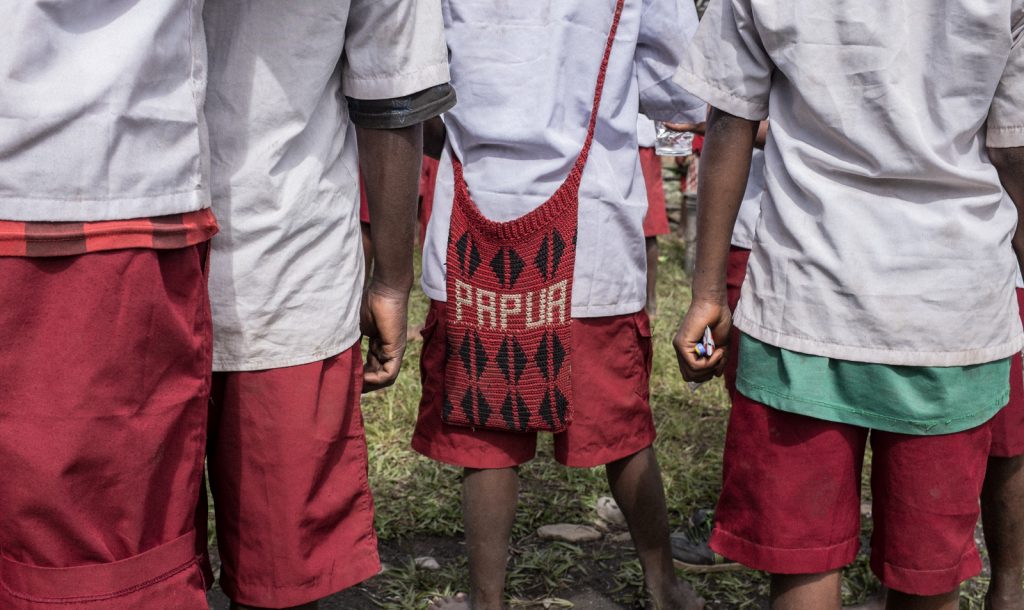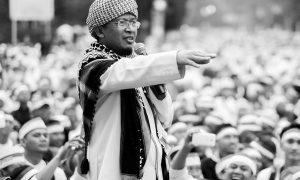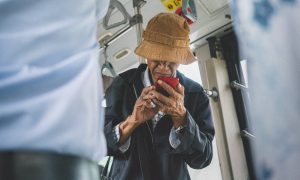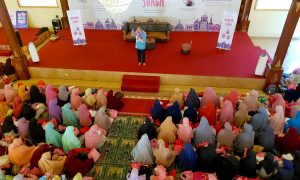In Indonesia, education is often portrayed as the great social panacea, a universal cure for social ills from political ignorance to social inequality. “Dasar manusia gak berpendidikan!” (“You uneducated human being!”) or “sekolah lagi sana!” (“[you should] go to school again!) are phrases many Indonesians often use in response to snarky social media commenters, or to news of corrupt politicians, lawbreakers, and juvenile delinquents. The implication, of course, is that if only these people were educated enough then their actions would not have happened or could at least be redeemed.
This attention to the redemptive powers of education is not isolated to the everyday logic of Indonesian citizens. Government development policies, along with numerous NGOs, have often used educational programs as a spearhead to combat “underdevelopment” in communities on the fringes of Indonesia. Indeed, Paul Gellert has argued that the prevailing top-down developmentalist approach recalls the Soeharto regime, now fused with a new cosmopolitan neoliberal ideology. The result is a mixture of nationalism (teetering on full blown hyper-nationalism) with a heightened degree of individualism, blind optimism and an intense desire to be part of the global community. Such an approach appeals to the urban middle class, due to its supposed effectiveness in producing the sort of individuals needed for Indonesia’s economic progress.
But what does it look like at the fringes of Indonesia, in areas lacking much of the basic infrastructure of urban and Javan areas, and where communities have different ideas about individual success and wellbeing? In this post I want to provide a snapshot of the problems of Indonesia’s education system as they appear in the district of Hitadipa, deep within the mountains of Papua.
Hitadipa is, by the standards of the Papuan highlands, reasonably well-connected with other communities. A gravel road connects it to the nearest town, Sugapa. Solar powered electricity, which automatically dies off every day around 9:30pm, was recently introduced to the area. Basic healthcare remains minimal if not non-existent. Churches are a powerful local force, as they help to provide many of these services, with some additional help from the central and local government.
There is one school that serves the district—but only until year 9, forcing students who wish to continue their studies to go to Sugapa, about an hour’s ride by motorbike. Of course, many do not have the privilege of this modern transportation. Education, as a number of young people I met in Hitadipa believe, will provide them access to future successes. To many, this means getting a good local job, typically in the government or church: teachers, church leaders, and doctors, along with village chiefs and elders, are highly respected there.
The central and local governments have been pushing higher quality formal education, particularly in relation to the curriculum and the processes of teaching and learning, as one immediate response to underdevelopment in communities like Hitadipa. What’s clearly missing, however, is consideration of whether education should be contextualised and tailored for people living in these remote areas of Indonesia.
Almost all of the young people at Hitadipa have been educated until year 9. A relatively high number of them continue their schooling to senior high school (years 10–12) in Sugapa. A lucky few have managed to go on to university in Jayapura, the provincial capital, or even to universities in Java, often choosing Jakarta or Yogyakarta (both options having their downsides in the form of the racial discrimination experienced by Papuan students in Java.)
Access to higher education is a big enough issue, yet the problems extend farther down than this. Many of the young people from the highlands opt to return to their villages or hometowns either because they want to help develop their local communities or be near their families. This seemingly selfless act also illustrates the complexity of their ideas of success and well-being, which are perhaps more rooted in community ideals than those of the more urban, cosmopolitan counterparts for which the Indonesian education system is geared.
Success for highland youth is underpinned by their familial and community relations, which sustain and expand their social capital within their communities. Maria, 22, who recently graduated from a university in Bandung, West Java, and is now back home living with her parents in Hitadipa, told me:
“I just recently finished my university degree in IT from Bandung, West Java, but I came back to Hitadipa and the only job that is available for me here is to help my parents, to take care of the farm. Even in Sugapa, where the local government has been looking for educated young people, the competition is so hard that I don’t think that I’ll get a job.”
Maria’s grievances reflect how the education she has received is disconnected from what she needs. Papuans are educated for a lifestyle that the central government perceives as more modern and more appropriate for a 21st century society. But in remote areas, the vast cultural and socioeconomic differences often render the “modern” education that they have received from cities pointless.
Education as a systematically enforced societal “upgrade” denies these young people the success that the education system has at many times pledged. Thus, when educating people living in the peripheries, the differences, complexities and nuances of their lives raises the question: for whom and for what purpose are they being educated?
In the Indonesian context, to have educational programs that adapt to local conditions presents a direct challenge to the current education system. Providing a contextualised educational program is not only to resist a hegemony of knowledge of what it means to be successful and modern, as defined by the Indonesian government. More than that, it is to push back against centralised forms of development that can and have marginalised already marginalised communities—“development” that has provided these communities with the things we think they need, rather than what they actually need.
This is not to say that Indonesian governments, both central and local, have not attempted to provide more contextualised, relevant and decentralised educational programs. Since 1987 Indonesia’s education system through a small national curriculum supplement has introduced muatan lokal (local content) or mulok, roughly translated into local curriculum subjects. These mulok, regulated and managed by local government educational bodies, including the local government of Papua, focus on the preservation of local languages, arts and cultures.
There is of course nothing wrong with this. In a world where local cultures, arts, languages are slowly being steamrolled by “modernity”, the preservation of local ways of being is crucial for local communities to maintain their identities and values. Yet with mulok being only one supplement subject within the national curriculum, it is insufficient for these fringe communities in confronting their changing socio-economic realities, especially when these realities are being constantly deconstructed and reconstructed by the onslaught of centralised development programs. The school in Hitadipa, for instance, only uses its mulok to teach the local language. This is praiseworthy but inadequate. Indonesia’s national curriculum can provide much more than this, not only for Hitadipa or Papua, but also for other areas as well.
The whole national curriculum itself needs to be contextualised for its students. Alongside having the local educational bodies add additional mulok that looks at the local history, socio-economic conditions, and politics, this would also mean having a flexible national curriculum that provides core subjects such as sciences, mathematics, reading, writing etc., which must not only engage in the universal knowledge, values and issues that the curriculum promotes but must also respond to the local realities of the students.

One example that the Indonesian government may learn from in educating its rural communities is a pioneering initiative from one of its very own citizens, Saur Marlina Manurung, or often known as Butet Manurung. Through her school Sokola Rimba, Butet Manurung (whom I confidently proclaim as the Indonesian version of the famed Brazilian critical educator Paulo Freire) provided education to the Orang Rimba community living deep within Bukit Dua Belas National Park. The content of the educational program itself was simple: to teach these marginalised communities living deep within the forest to read, write and count.
The how and why is much more interesting. Butet not only approached the method of teaching and learning from an anthropological perspective, in which the local culture was at the centre of the pedagogy, but also worked together with the Orang Rimba in how these knowledges can be useful for them rather than such knowledges simply being imposed.
Pushing her educational and political agenda further, the curriculum and teaching and learning processes of Sokola Rimba are also contextualised with the socio-economic conditions of the Orang Rimba. With illegal logging and land grabbing an immense problem for their community, the Orang Rimba suffered immensely from their lack of literacy and numeracy. In her book about her experiences with Sokola Rimba, Butet noted that the Orang Rimba would often be deceived in signing papers, only to later regretfully realise that they just signed a land sale agreement. Although the education she provided seemed very basic, by providing a socio-political purpose for learning on how to read, write and count contextualises their education within their socio-economic realities.
The tricky part of Butet’s initiative, of course, is how to institutionalise the innovations presented by Sokola Rimba within government educational policies. A radical change in the national curriculum towards more contextualised content will require a massive effort by the government to understand the local contexts of students. This would not only require deep and continuous partnerships with local communities, but also with the invaluable knowledge and skills of anthropologists and rural sociologists (who have at times been sidelined by Indonesian policy makers, or used to merely support and promote central government development policies).
But on a more foundational level, such a new approach to schooling would also require a fundamental shift in how the purpose of education and its relationship to “modernity” is understood in Indonesia. It means embracing the idea that being a modern human being must not necessarily fully equate with the ideals of urban life, and that success extends much farther than simply getting a good office job in big cities.
All images credited to the author.
 Facebook
Facebook  Twitter
Twitter  Soundcloud
Soundcloud  Youtube
Youtube  Rss
Rss 











